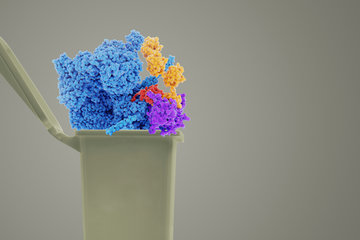Type IV effector complexes
Scientists discovered new components of the last elusive CRISPR-Cas type
Bacteria utilize CRISPR-Cas systems to defend themselves against viral attacks. Six major CRISPR-Cas types have been classified based on the presence of signature proteins. Five of these six types are characterized well. Scientists of the Max Planck Institute for Terrestrial Microbiology have now uncovered the components of the elusive type IV system, which include a novel CRISPR-RNA nuclease. The funcional roles of these discovered Type IV effector complexes are suggested to be found outside of viral defense.

CRISPR-Cas systems are found in bacterial and archaeal cells, where they constitute immune systems that identify and destroy harmful foreign genetic material. CRISPR arrays usually contain fragments of viral genomes as a memory of previous viral attacks. This genetic information is incoporated into CRISPR RNAs (crRNAs) that guide Cas effector proteins to the viral target genomes. The coevolution of CRISPR-Cas systems and viral anti-CRISPR measures resulted in the diversification of Cas effector proteins that assemble into a large variety of ribonucleoprotein complexes.
The current classification of CRISPR-Cas systems is largely based on the occurrence of signature Cas proteins and identifies major 6 types and over 30 subtypes. Many CRISPR-Cas systems have been described in detail and the multisubunit Escherichia coli complex (Cascade, Type I) or the Cas9 effector protein (Type II) are frequently used as genome engineering tools. Now, researchers from the Max Planck Institute for Terrestrial Microbiology in Marburg have provided first experimental results for the last unstudied CRISPR-Cas type, classified as Type IV of the bacterium Aromatolaeum aromaticum.
In a recent manuscript, Ahsen Özcan, the first author of the study, describes the identification of a Type IV crRNA processing pathway and four proteins that are required for effector complex formation. In a highly collaborative effort, the laboratory of Lennart Randau teamed up with the groups of Gert Bange, Johan Heider, Thomas Heimerl and Henning Urlaub to obtain structural information on the involved Cas proteins and their interactions within the complex. The protein Csf5 was crystallized in complex with a processed RNA component, which revealed that these Type IV-specific crRNAs contain unusual 7 nt CRISPR repeat stretches at their 5‘ termini.
Transmission electron microsocpy and protein-protein crosslinking highlighted that the mature crRNA is bound by several subunits of a backbone Csf2 protein, generating crescent-shaped CRISPR ribonucleoproteins that resemble known Type I effector complexes.
These structural similarities suggest that Type IV effector complexes can also be guided by crRNAs to identifiy viral targets. However, Cas proteins, both for the integration of viral fragments into a CRISPR and for the destruction of target DNA are apparently missing for Type IV systems. Therefore, additional functions beyond viral defense are plausible and CRISPR-Cas systems could modulate genome or plasmid stability.












